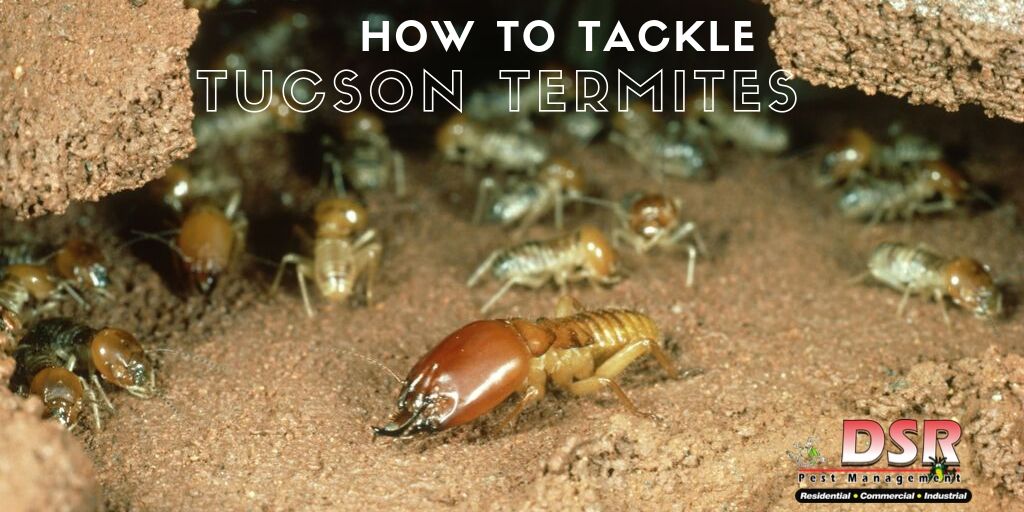Tucson, also known as the “Old Pueblo”, is celebrated for its diverse landscape, which includes flowering desert, rolling hills, winding dry riverbeds, rugged canyons, and pine-topped peaks. Due to many factors, including steep elevation changes, warm subtropical climate, and the dance between temperate and tropical weather, Tucson has a unique makeup of insects commonly found and sometimes, fought.
Here are just a few of Tucson’s backyard bugs and ways you can spot them. We also share whether or not they pose any threats to your home or household. Once you find your pest with the bug identifier, don’t forget that your Tucson Pest Management team that you can trust to get rid of them is DSR Pest Management.
Tucson Bees & Wasps
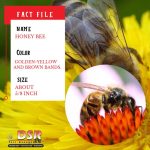 Honeybees
Honeybees
Honeybees are seen mostly during the day time during Spring, Summer, and Fall. It isn’t uncommon to see them in winter on Tucson’s warmer days. They are most commonly near flowers, as they are responsible for pollinating many Tucson plants.
Honeybees do have hives – though rarely reported – and will defend their residence if feeling threatened. Honey Bee removal should always be done by a professional for both your safety and for the bees’.
 Carpenter Bees
Carpenter Bees
Carpenter Bees are also fans of flowers. They enjoy the warmer weather and can be spotted during the Spring, Summer, and Fall months. The females are known for “nesting” in dead wood, hence their name. They are not typically aggressive unless they believe they are under attack.
 Paper Wasps
Paper Wasps
Paper wasps enjoy the warmer seasons (Spring through Fall). They can typically be found tending their nests or visiting flowers for nearby nectar. They are capable of administering a very painful sting and should be cautiously observed. Do not provoke them, especially near their intriguing, yet vulnerable, honeycomb dwellings.
Tucson Common Ants, Flies, & Mosquitos
 Carpenter Ants
Carpenter Ants
Carpenter Ants are typically ½ inch longer than most ants. Their waist is pinched, similar to a wasp’s. They enjoy eating wood, leaving small piles of sawdust where they kick out their excrement.
These ants are mostly active at the start of sunset and prefer to work solo. Still, they are part of a Queen-led colony nearby. Carpenter ants do not sting, however, they can bite. They also have the ability to spray an acid that causes irritation to the skin.
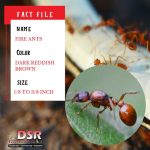 Fire Ants
Fire Ants
Fire ants tend to nest in mounds of dirt or sand and are aggressive when disturbed. They are capable of stinging which can leave a permanent scar or even prompt an allergic reaction. Fire ants stay in large colonies with typically multiple queens. They prefer moist areas like your garden, making hotter temperatures a deterrent to their activity.
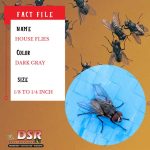 House Flies
House Flies
House flies are typical all across the globe and Tucson is no exception. While annoying, house flies do play a very important role in breaking down trash, feces and animal corpses. Unfortunately, they also enjoy landing on human food, which can spread human diseases.
They particularly like hot weather, as it is conducive to laying their eggs (maggots, once hatched). Their eggs can hatch quickly (within 3 weeks) when animal feces is present. For this reason, it is wise to clean up after your pets quickly, as well as, keep your garbage cans clean of un-bagged waste.
 Mosquitoes
Mosquitoes
Mosquitoes like to live near your home. Here, they can enjoy everything from standing water in pet bowls, shelter from the sun and easy access to humans. This is ideal for the female mosquitoes, which suck blood to develop and lay their eggs.
Their blood-sucking involves their saliva, which is left behind when they bite and causes itching. Mosquitoes are active in Tucson from April through late fall with their presence at peak during dawn and dusk.
Tucson Cockroaches
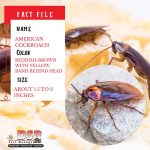 American Cockroaches
American Cockroaches
American cockroaches are also known as water bugs. They have reddish-brown bodies that are about 1.5 inches long. They will eat anything, including the back of wallpaper! They are commonly found in kitchens, pantries or anywhere food storage is likely.
American cockroaches travel as a family and are most active at night in the dark. See the bug identifier images below for a couple of other types of cockroaches you might end up finding in your home.
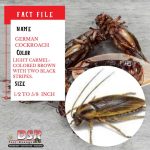 German Cockroaches
German Cockroaches
German cockroaches will eat anything. They hide during the day, foraging for food at night. They are rarely an inch long and prefer residential areas. They actually invade homes by transporting via clothing. German cockroaches are known for their two brown stripes on their heads.
 Oriental Cockroach
Oriental Cockroach
The Oriental Cockroach is also known as a “black beetle”. Coming in at about 1 ¼ inches long, it has wings but does not fly. They congregate near trashcans and do not need a water source, making Tucson-climate an easy atmosphere to dwell in. They are the filthiest of all cockroaches and prefer decayed organic matter over other food sources.
Tucson Termites
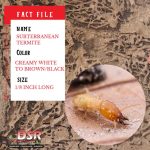 Subterranean Termites
Subterranean Termites
Subterranean termites are small insects that make their homes in soil and wood. They can be a problem for homeowners because they often damage wood sheds, fences, and houses. These termites prefer moist areas to transport to and from their nest and food source.
Finding them is more so about finding their “mud tubes”. Subterranean termite treatment is needed if you find tunnels at the base of your house. Call us for a free inspection today!
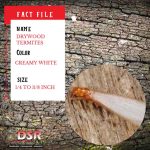 Drywood termites
Drywood termites
Drywood termites are air-borne pests. They can access your home from any point of entry and dwell inside your property. They are often spotted by their pilings of sawdust left behind as they “kick out” holes along wooden structures.Generally between ¼” – 3” and light tan in color, the Bark Scorpion is the most common scorpion in Tucson. They climb well and can be found crossing your floors or even hanging from your ceilings. Their venom contains a potent neurotoxin that can result in a variety of symptoms.
Symptoms can range from very little swelling, sensitivity to touch, and numbness to difficulty breathing, drooling, irregular heartbeat and unusual head, neck, and eye movements. This is most common in those with weakened immune systems like infants, young children and elderly in your household.
Tucson Native Scorpions & Spiders
 Bark Scorpions
Bark Scorpions
Generally between ¼” – 3” and light tan in color, the Bark Scorpion is the most common scorpion in Tucson. They climb well and can be found crossing your floors or even hanging from your ceilings. Their venom contains a potent neurotoxin that can result in a variety of symptoms.
Symptoms can range from very little swelling, sensitivity to touch, and numbness to difficulty breathing, drooling, irregular heartbeat and unusual head, neck, and eye movements. This is most common in those with weakened immune systems like infants, young children and elderly in your household.
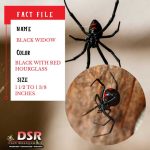 Black Widows
Black Widows
Black Widows are best known for their dark black bodies and red hourglass marking on their back. Typically about 1 ½ inches long, they pack a punch with their bite.
Despite their reputation, black widow spiders aren’t aggressive and only bite when they feel threatened. The bites usually aren’t fatal, but they can still cause some serious and uncomfortable symptoms. This can range from difficulty breathing (which is due to paralysis of the diaphragm), nausea, chills, fevers and more.
In very rare cases, they have also been linked to the onset of seizures and the occurrence of death. For this reason, any suspected venomous bites from a black widow warrant immediate medical attention.
 Scorpion spiders
Scorpion spiders
Scorpion spiders are as creepy and as dangerous as they sound. They have been identified also as “camel spiders”, “sun spiders” and “wind spiders”. They are, in fact, neither scorpion, nor spider, but a cousin of both.
Despite a body of about 5/8 inches to 1 ¾ inches, its powerful pinchers make it capable of eating small rodents. Fortunately, this desert danger is neither venomous nor a threat to humans and pets. Though, it is best to not handle them and call in Pest Management specialists to remove them from your home.
Tucson Small Bugs with Stripes
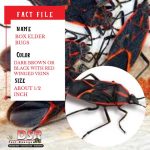 Box Elder bugs
Box Elder bugs
Box Elder bugs are a breed of their own. They are often mistaken for Kissing Bugs, however, they differ in a few ways (see the bug identifier below for the kissing bug).
When scoping your property for box elder bugs, you may find them lingering in plants and trees. They feed and lay eggs on them during the warmer months. However, these bugs do not depart come colder months.
Rather, they migrate in large numbers to the crevices of your household until they find places to settle in. They sport a body that is black with reddish or orange markings on their back. Their body shape is a somewhat-flattened and elongated oval that is about 1/2 an inch long.
Removing these pests is important, especially prior to the winter months. The colder months are when they swap congregating outdoors for sharing your residence.
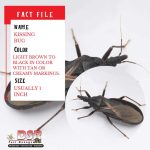 Kissing Bugs
Kissing Bugs
Kissing Bugs are one bug you do not want anywhere near your face. These bugs are light brown to black with some species having red, yellow or tan markings on their abdomen. They are typically between ½ inch and one inch long. They are a pest because their “kiss” can come with a bite, typically to the face.
Kissing bugs are usually found living in hollow trees but if they find their way into your home – via a crack in the foundation or a broken window screen – they may soon find their place next to you at night. They hide during the day and feed at night, on mammals. So your family and pets are at risk of their bites.
Their attacks are known to carry a parasite that has caused many fatalities around the world. Symptoms of this parasite, labeled as Chagas disease, include fever, fatigue, body aches and headaches. It also may leave a rash where the parasite entered the body and prompt swelling around the eyelids.
Tucson Big Beetles
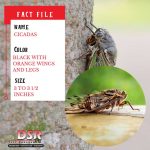 Cicadas
Cicadas
Even if you haven’t seen them, you’ve likely heard them. Cicadas are known for their loud buzzing sounds the males make to attract females. They are often mistaken for locusts, even though they aren’t related to them. Cicadas are fairly large-winged creatures ranging from ¾ in. up to 2 ¼ in. They have black bodies, prominent red eyes and orange wing veins.
While cicadas do not pose any health threats to humans, they are considered a nuisance pest. This is due to their attack on small trees, as well as, the volume of their community. Typically, there can be hundreds of thousands of cicadas per acre.
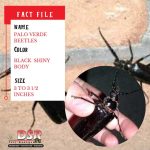 Palo Verde Beetles
Palo Verde Beetles
Palo Verde Beetles get their name from the very tree they love to feast on. They also share the name Arizona Borer Beetle and are often misidentified as a giant cockroach. They are harmless to people and can grow to a whopping 3 to 3 ½ inches in size. These beetles boast long antennae and spiny collars.
The bug identifier picture doesn’t really give it justice. If you haven’t seen one before, you may find them feeding on the roots of distressed trees and shrubs. They are fans of the Mexican Palo Verde tree and citrus trees. This quickly turns them into pests once they damage your landscape.
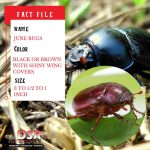 June Bugs
June Bugs
June Bugs, or “June Beetles” are approximately ½ inch to 1 inch in size. They have wide bodies with shiny wing covers. They can become a nuisance pest quickly as they feed on foliage and flowers.
June Bugs also can do considerable damage to lawns and landscape as they chop off grasses from their roots. They do not bite or sting, however, their small larvae can feed on your property for up to 3 years.
If you find your self with any of these pests from the bug identifier above and you want to get rid of them, look no further than your reliable Tucson Pest Management service, DSR Pest! Give us a call or request an inspection.


